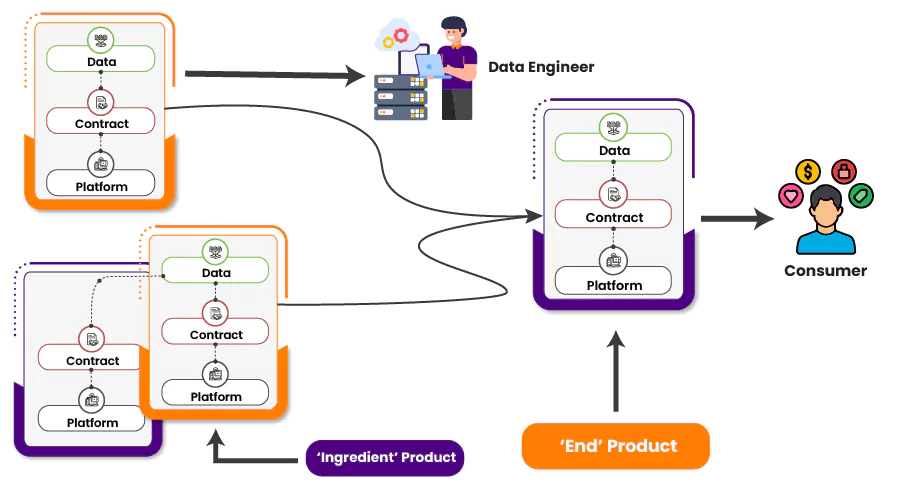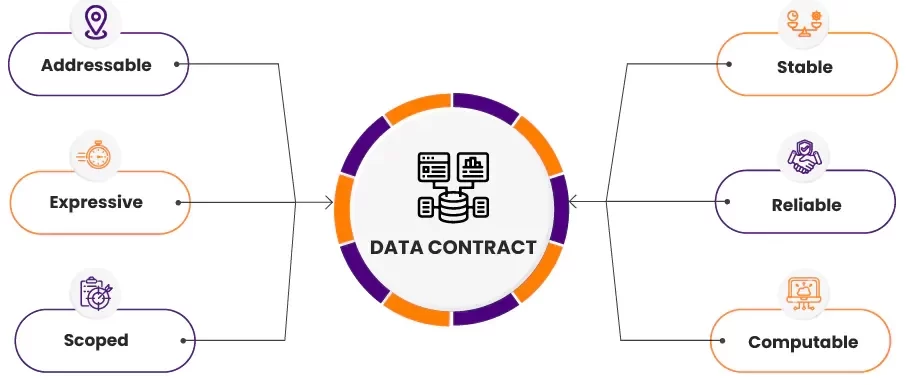In today’s data-driven landscape, ensuring data quality is crucial for deriving accurate insights and driving informed decisions. Data contracts emerge as a powerful tool to establish trust, consistency, and transparency within data pipelines. By explicitly defining expectations for data structure, format, and constraints, data contracts help teams build robust and reliable data flows, ultimately enhancing data quality (DQ).
Understanding Data Contracts
 https://medium.com/@maxillis/on-data-contracts-data-products-and-muesli-84fe2d143e2c
https://medium.com/@maxillis/on-data-contracts-data-products-and-muesli-84fe2d143e2c
At a high level, data contracts define the expected structure, format, and quality standards for your data. These contracts serve as agreements between data producers and consumers, establishing a common understanding of the data’s characteristics. By adhering to these contracts, organizations can mitigate errors and inconsistencies in their datasets.
Why Data Contracts Matter
- Consistency:Data contracts promote consistency in data value lifecycles, making it easier for different teams to work with the same data. Such a process ensures that everyone speaks the same data language.
- Error Detection and Prevention: Contracts act as a safety net by identifying inconsistencies early in the data pipeline. This prevents flawed data from propagating through subsequent stages, saving time and resources.
- Bridging semantics and create a common lingua franca between technology and business: Define data meaning, structure, and usage, creating a shared understanding crucial for smooth collaboration. Data contracts empower this transparency, fostering trust and ensuring data is used effectively, ethically, and securely.
Key elements of a data contract
- Schema: Data types, field names, and constraints for each data element, ensuring everyone speaks the same language, like having standardized sheet music for all instruments.
- Data formats: Whether it’s CSV, JSON, Parquet, or any other supported format, clarity is key, just like specifying the instruments required for each piece.
- Structures: Simple atomic data is the fundamental unit, like a single Lego brick. It represents basic values like numbers, text, or dates. These are indivisible and have a single, well-defined meaning. Complex data types, on the other hand, are like intricate Lego structures. They organize and combine multiple simple data units to represent richer concepts. Examples include:
- Spatial data: This goes beyond basic addresses, encoding 3D coordinates, shapes, and relationships between objects, useful in maps and simulations.
- Location data: More than just coordinates, it captures detailed information like floors, zones, and landmarks, relevant for indoor navigation and asset tracking.
- Hierarchy data: This model structures with levels and relationships, like family trees, organizational charts, and product categories, crucial for understanding complex systems.
Choosing the right structure depends on the data’s nature and purpose. Simple atomic data excels in efficiency and storage, while complex data types offer richer representation and deeper insights, though with more complexity to manage.
- Business rules: Valid values, relationships between data elements, and data quality expectations, setting the bar for acceptable data, like defining acceptable tempo and dynamics for each section.
- Versioning: Tracking changes and ensuring compatibility between producers and consumers, preventing compatibility chaos, similar to having version control for sheet music revisions.
Benefits of Data Contracts

https://onedata.de/en/data-mesh-hub/data-contract/
- Enhanced Trust and Transparency: Data contracts is like an understanding between data producers and consumers, outlining data characteristics and expectations. This transparency enhances trust and collaboration and minimizes misunderstandings and data-related issues.
- Improved Data Quality: Data contracts enable validation and enforcement of data integrity rules, preventing invalid or inconsistent data from entering downstream systems. This proactive approach significantly improves data quality downstream.
- Simplified Data Governance: Data contracts provide a structured way to document data lineage and ownership, facilitating effective data governance practices. This clarity aids in regulatory compliance and auditability.
- Streamlined Data Integration: Data contracts facilitate smoother data integration between diverse systems, ensuring data compatibility and reducing integration challenges. This promotes efficient data exchange and analysis.
- Automated process: Data contracts can be used to automate data validation processes during data transformation. This helps in significantly reducing manual effort and improving efficiency. Also, one can automate error detection and correction, further bolstering data quality.
Single Source of Truth through Data Quality & Governance
graph LR;
A[Data Source 1] --> B(Standardize) --> C{Conformed Data};
A --> B --> D{Corrected Data};
C --> E(Prevent Errors) --> F{Single Source of Truth};
D --> E --> F;
Implementing Data Contracts in dbt (Data Built Tools)
dbt, a popular data transformation tool, offers seamless integration with data contracts. Here’s a high-level overview of the process:
- Define Data Contracts: Begin by meticulously defining data contracts for your models, specifying:
- Data elements (columns)
- Data types (e.g., string, integer, date)
- Constraints (e.g., mandatory fields, valid value ranges)
- Documentation (explanatory descriptions for each data element)
In dbt, defining data contracts involves creating schema.yml files. These files outline the expectations for each table, specifying column names, data types, and any necessary constraints.
Consider the following example:
version: 2
models:
- name: my_model
columns:
- name: id
description: "Unique identifier"
tests:
- unique
- name: name
description: "Name of the entity"
tests:
- not_null
- accepted_values: ['Alice', 'Bob', 'Charlie']
# Add more columns as needed
2. Utilize dbt Packages: Leverage dbt packages like dbt-datamesh or dbt-expectations to manage data contracts within your dbt project. These packages provide templates and tools to streamline data contract creation and integration.
Consider the example:
-- Transform data with metadata
SELECT
id,
name,
{% if target.schema == 'my_target_schema' %}
UPPER(name) as upper_name
{% else %}
name
{% endif %}
FROM
{{ ref('my_model') }}
3. Leveraging Metadata during Runtime:
dbt exposes data contract metadata as variables directly within your models. This enables powerful functionalities:
- Conditional logic: Check specific data contract properties to adjust transformations based on data characteristics.
- Documentation generation: Automatically generate comprehensive data dictionaries using data contract information.
- Custom validations: Write custom Python functions to validate data against additional criteria using the contract metadata.
Here’s an example of using data contract metadata to filter records:
{% if source.fields.last_purchase_date.description == 'Date of the customer's last purchase' %}
-- Only keep records with valid purchase dates
where last_purchase_date is not null
{% endif %}
4. Automate Data Validation: dbt models can be configured to automatically validate data against defined contracts during transformation. This helps in pointing the issues early in the existing pipeline, minimizing downstream impact.
5. Continuously Monitor and Improve: Regularly revie5w data contracts and adjust them as needed to reflect evolving data requirements. Monitor data quality metrics to identify areas for improvement and refine your data contracts accordingly.
Additional Considerations
- Tool Selection: Choose data contract tools that align with your technology stack and workflow preferences.
- Version Control: Implement version control for your data contracts to track changes and ensure consistency.
- Documentation: Maintain clear and concise documentation for your data contracts to facilitate understanding and collaboration.
- Collaboration: Foster a collaborative environment where data producers, consumers, and governance teams actively contribute to data contract development and maintenance.
Beyond dbt: Expanding the Data Contract Universe
While dbt provides a fantastic foundation, data contracts can extend their reach beyond individual transformation tools. Consider these additional avenues:
- Standardized frameworks: Explore frameworks like Datahub or Amundsen for broader contract management and visibility.
- Contract-based data sharing: Leverage frameworks like Enigma or Glue to securely share data while enforcing contracts across organizations.
- Contract-driven data governance: Integrate data contracts with governance tools to automate enforcement and streamline compliance processes.
Bottom Line
Data contracts play a crucial role in ensuring data quality and reliability within modern data pipelines. By considering data contracts and leveraging DBT’s capabilities, you can establish trust, transparency, and consistency in your data flow, ultimately helping your organization to make data-driven decisions with confidence.
Sources:
- Datahub: https://datahubproject.io/
- Collibra: https://collibra.com/
